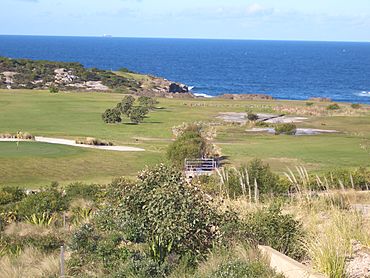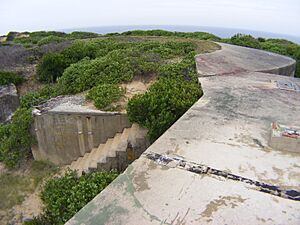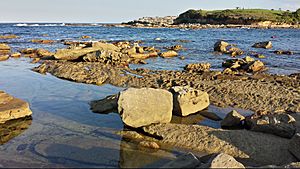Little Bay, New South Wales facts for kids
Quick facts for kids Little BaySydney, New South Wales |
|||||||||||||||
|---|---|---|---|---|---|---|---|---|---|---|---|---|---|---|---|

The Coast Golf Course, Little Bay
|
|||||||||||||||
| Population | 2,937 (2011 census) | ||||||||||||||
| Postcode(s) | 2036 | ||||||||||||||
| Elevation | 39 m (128 ft) | ||||||||||||||
| Location | 14 km (9 mi) south-east of Sydney CBD | ||||||||||||||
| LGA(s) | City of Randwick | ||||||||||||||
| State electorate(s) | Maroubra | ||||||||||||||
| Federal Division(s) | Kingsford Smith | ||||||||||||||
|
|||||||||||||||
Little Bay is a suburb in the eastern part of Sydney, in New South Wales, Australia. It's located about 14 kilometres south-east of the main city area. Little Bay is a coastal suburb, meaning it's right by the ocean, and it gets its name from a small, pretty bay and beach. A famous hospital, the Prince Henry Hospital, used to be here.
Contents
History of Little Bay
The Little Bay area was first used in 1881–82 as a special camp. This was during a smallpox outbreak in Sydney. The camp helped keep healthy people separate from those who were sick. At first, people lived in tents on the beach. But soon, the government decided to build a permanent hospital here. This hospital was for treating people with infectious diseases. Little Bay was a great spot because it was away from other towns but still close enough to Sydney.
The Coast Hospital and Prince Henry Hospital
The hospital was first called the Coast Hospital. It was very important during the bubonic plague in Sydney in 1900. It also helped when soldiers came back from Europe with the influenza virus in 1919. In 1934, the Coast Hospital changed its name to Prince Henry Hospital. In 2001, the hospital services moved to another hospital, and the land became available for homes.
Today, there are still 19 old buildings from the Coast/Prince Henry hospital days. These buildings are protected because of their history.
Old Landmarks from Hospital Days
Two important landmarks from the hospital days are still here. One is the Coast Cemetery, which is south of Little Bay. Over 2,500 people were buried there. The oldest graves are further south, near Cape Banks. The cemetery is now part of the Botany Bay National Park. Many of the graves are covered by plants to help protect them.
Another landmark is the Interdenominational War Memorial Chapel. It sits on a hill overlooking Little Bay. A fire destroyed it in 1981, but it was rebuilt in 1982. Outside the chapel, you can see many plaques. These remember the people who used to work at the hospital.
How Little Bay Got Its Name
Little Bay was first called Yarra Junction. But mail kept going to a place in Melbourne with a similar name! So, the people living there asked for a new name. It was then called Phillip Bay Heights. However, everyone kept calling the area Little Bay. So, that's the name that officially stuck. In the 1950s, much of the land was given to soldiers who had returned from war.
The "Wrapped Coast" Art Project
In 1969, two famous international artists, Christo and Jeanne-Claude, created a huge art project here. It was called "Wrapped Coast – One Million Square Feet, Little Bay, Sydney, Australia". It was the largest sculpture in the world at that time! Many Australian artists and students helped them. They wrapped 2.4 kilometres of coastline with fabric. The wrapped area was between 46 and 244 metres wide and up to 26 metres high. This was a very new and different kind of art. It caused a lot of discussion and different opinions. But today, it's seen as a very successful and important art project. Christo and Jeanne-Claude later wrapped other things, like cars, islands, and even the Reichstag building in Germany.
Little Bay Beach
Little Bay Beach is a special sandy beach south of Sydney Harbour. It's the last big sand beach before you reach Botany Bay. The beach is shaped like a half-circle and has land on both sides. Its narrow entrance helps protect it from strong ocean waves.
In the early 1900s, a swimming pool was built at the southern end of the beach. It was made from rocks found on the beach. This pool, called Little Bay Rock Pool or Little Bay Baths, gave nurses from the nearby hospital a safe place to swim away from sharks. Parts of this pool are still there today.
Little Bay is not a surfing beach. It usually doesn't have strong currents unless there are very big waves from the south or south-east. There are no lifeguards patrolling the beach. However, surf lifesavers and the Westpac Life Saver Rescue Helicopter Service do help if there's an emergency. Fishing from the rocks along the coast is very popular. But it can be dangerous, and sometimes accidents happen. You can find more safety information on the Little Bay Beach website.
In February 2022, a diving instructor was sadly killed by a white shark while swimming near Little Bay Beach. This was the first shark fatality in Sydney's coastal waters since 1963.
Clean Water at Little Bay Beach
As Sydney's population grew, beaches south of the Malabar sewage treatment plant, like Little Bay, became quite dirty. By the 1980s, the water was brown, and greasy stuff was on the sand and rocks. But after a new deep-ocean pipe started working in 1990, the beaches became much cleaner very quickly. Today, Little Bay is known as one of Sydney's cleanest beaches. The water is clear, and it has low levels of bacteria.
Landmarks in Little Bay
The northern headland of Botany Bay, called Henry Head, has some interesting features. These include two old gun emplacements at Fort Banks. There's also a lighthouse and the wreck of a ship called the SS Minmi near a place called Pussycat Island. The older gun emplacements, known as the Henry Head Battery, were built to help protect the entrance to Botany Bay.
Other important landmarks include:
- Former Prince Henry Hospital site
- Spinal Cord Injuries Australia
- Aboriginal Health College
- Prince Henry Development Project (new homes and facilities)
- Little Bay Weather Station
Famous People from Little Bay
Some well-known people have lived in Little Bay:
- Russell Fairfax, a rugby league player
- Greg Inglis, a rugby league player
- Anthony Maroon, a radio personality
- Tony Rafty, a cartoonist
- Jane Saville, a race walker
- Fiona Stanley, a children's doctor and the 2003 Australian of the Year
- David Warner, a Test cricketer
- Nathan Williamson, a broadcaster and journalist
Street Names in Little Bay
Many street names in Little Bay come from Aboriginal words or are named after important people. Especially those linked to medicine because of the former Prince Henry Hospital.
| Name | Meaning or Derivation |
| Abbe Receveur Place | Named after Louis Receveur, a scientist who sailed with La Perouse |
| Alkoo Avenue | Aboriginal word meaning "visitor" |
| Anzac Parade | Named to remember when the First Australian Imperial Force camped nearby |
| Bega Avenue | Aboriginal word meaning "large camping ground" |
| Binda Crescent | Aboriginal word meaning "deep water" |
| Brodie Avenue | Named after surgeon Sir Benjamin Brodie |
| Budd Avenue | Named after an early female resident |
| Bunnerong Road | Aboriginal word meaning "sleeping lizard" |
| Coast Hospital Road | Named after The Coast Hospital, the original name for Prince Henry Hospital |
| Curie Street | Named after famous scientists Pierre and Marie Curie |
| Darwin Avenue | Named after naturalist Charles Darwin |
| Dawes Avenue | Named after Lieutenant William Dawes from the First Fleet |
| Dwyer Avenue | Named after Matt Dwyer, a former Mayor of Randwick |
| Ewing Avenue | Named after pathologist James Ewing |
| Fleming Street | Named after bacteriologist Alexander Fleming |
| Florey Crescent | Named after pharmacologist and pathologist Howard Florey |
| Gipps Avenue | Named after Sir George Gipps, a former Governor of NSW |
| Goora Street | Aboriginal word meaning "long" or "tall" |
| Grose Street | Named after Francis Grose, the first Lieutenant-Governor of NSW |
| Gubbuteh Road | Aboriginal word meaning "ochre", named after local ochre deposits |
| Gull Street | Named after physician Sir William Gull |
| Harvey Street | Named after physician William Harvey |
| Jenner Street | Named after surgeon Edward Jenner |
| Lister Avenue | Named after surgeon Joseph Lister |
| Little Bay Road | Named after nearby Little Bay |
| Marconi Place | Named after Guglielmo Marconi, who developed the wireless telegraph |
| Mayo Street | Named after physician William Worrall Mayo |
| McMaster Place | Named after Jean McMaster, who started the Nurses' Training School at Prince Henry Hospital |
| Meyler Close | Named after Mary Meyler, the first matron (head nurse) of Prince Henry Hospital |
| Millard Drive | Named after Dr Reginald Millard, a medical superintendent at The Coast Hospital |
| Mirrabooka Crescent | Aboriginal word for the "Southern Cross" (a star constellation) |
| Murra Murra Place | Aboriginal word meaning "sea mullet" (a type of fish) |
| Newton Street | Named after Sir Isaac Newton |
| Noora Avenue | Aboriginal word meaning "camp" |
| Nurla Avenue | Aboriginal word meaning "plenty" |
| Pavilion Drive | Named after the special "pavilion wards" at Prince Henry Hospital that allowed fresh air for patients |
| Pine Avenue | Named because Norfolk Island pine trees were common at Prince Henry Hospital |
| Reservoir Street | Named because there is a water reservoir nearby |
| Woomera Road | Aboriginal word – see woomera (a tool for throwing spears) |
Transport in Little Bay
Little Bay is served by five bus services, run by Transdev John Holland. These buses connect Little Bay to other parts of Sydney.
| Route number | From | To | Service | Timetable |
| 390X | La Perouse | Bondi Junction railway station | Express | Route 390X timetable |
| 392 | Little Bay | Redfern railway station | Regular | Route 392 timetable |
| 392X | Little Bay | Museum railway station | Express | Route 392X timetable |
| 394X | La Perouse | Museum railway station | Express | Route 394X timetable |
| 399 | Little Bay | University of New South Wales | Regular | Route 399 timetable |
Sport and Recreation
Little Bay has some great places for sports and fun:
- St Michael's Golf Club
- The Coast Golf Club
- Surf Life Saving Sydney, which has an office here. Surf Life Saving Sydney helps keep people safe at beaches.







